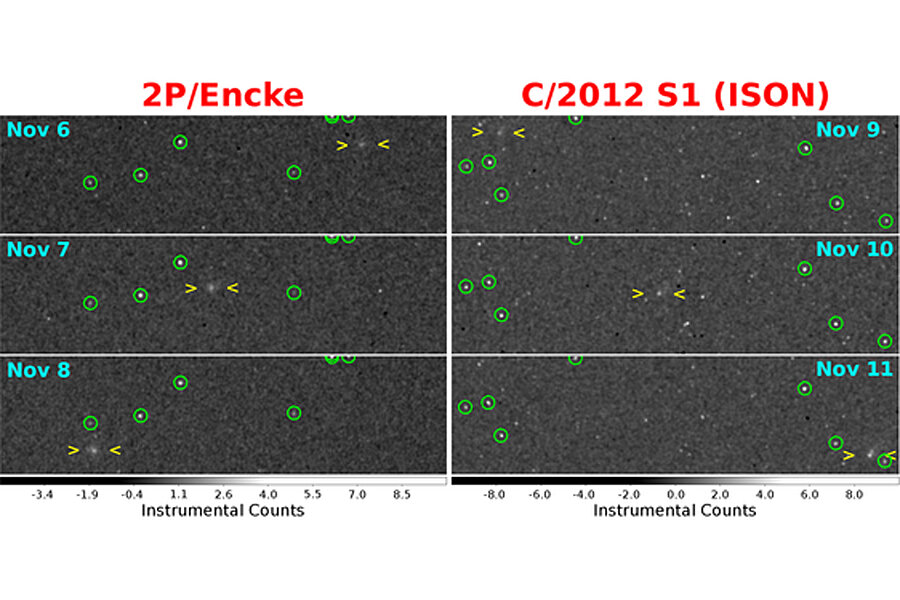NASA probe to watch comets Encke, ISON zip past Mercury
Loading...
A NASA spacecraft orbiting Mercury will have a ringside seat when two comets zip by the tiny planet on Monday and Tuesday (Nov. 18 and 19).
NASA's MESSENGER probe will watch as comets Encke and ISON cruise by on back-to-back days, providing "a golden opportunity to study two comets passing close to the sun," Ron Vervack of Johns Hopkins University, a MESSENGER science team member, said in a statement. NASA scientists explained the Mercury double-comet flyby in a video released Friday.
MESSENGER is well equipped to study the composition of the icy wanderers, which should be shedding material like mad at this point, Vervack said. [Comet ISON: 8 Essential Facts]
"We hope to obtain the first definitive detections of X-ray emissions from silicon, magnesium and aluminum," he said. "If you think of a comet as a dirty snowball, these are elements that make up the dirt. Close to the sun is where we expect the dirt to be vaporized."
All eyes are on Comet ISON as it barrels toward a risky Thanksgiving passage by the sun Nov. 28. Some astronomers say it could be ripped apartas it approaches within 724,000 miles (1.16 million kilometers) of the solar surface.
Others, however, believe that the comet will not only survive but put on a great skywatching show once it becomes visible again in early December. (The comet is currently visible to the naked eye after a recent outburst.)
"MESSENGER's glimpse of Comet ISON as it plunges inward could give astronomers the data they need to predict the comet’s fate," NASA stated of ISON's close approach on Tuesday, which will bring the comet within 0.24 astronomical units of Mercury. (One astronomical unit is the distance from Earth to the sun — about 93 million miles, or 150 million km.)
Comet Encke — which passes by Mercury's orbit once every 3.3 years — has put on a show for NASA spacecraft in the past. In 2007, the twin STEREO spacecraft (which usually gaze at the sun) watched a solar storm tear apart Encke's tail, which then grew back again.
Encke also happens to be the origin of the Taurid meteor shower, which occurs in November and just passed its peak a few weeks ago. The comet will get within 0.025 AU of Mercury on Monday.
NASA plans to release images from the flybys a few days after they occur.
Editor's note: If you snap an amazing picture of Comet ISON, Comet Encke or any other night sky view that you'd like to share for a possible story or image gallery, send photos, comments and your name and location to managing editor Tariq Malik at spacephotos@space.com.
You can follow the latest Comet ISON news, photos and video on SPACE.com.
Follow Elizabeth Howell @howellspace, or SPACE.com @Spacedotcom. We're also on Facebook and Google+. Original article on SPACE.com.
- Two Comets To Fly-By Mercury, Probe To Watch | Video
- Photos of Comet ISON: A Potentially Great Comet
- Comet Quiz: Test Your Cosmic Knowledge
- Latest Photos of Mercury from NASA's Messenger Probe
Copyright 2013 SPACE.com, a TechMediaNetwork company. All rights reserved. This material may not be published, broadcast, rewritten or redistributed.





